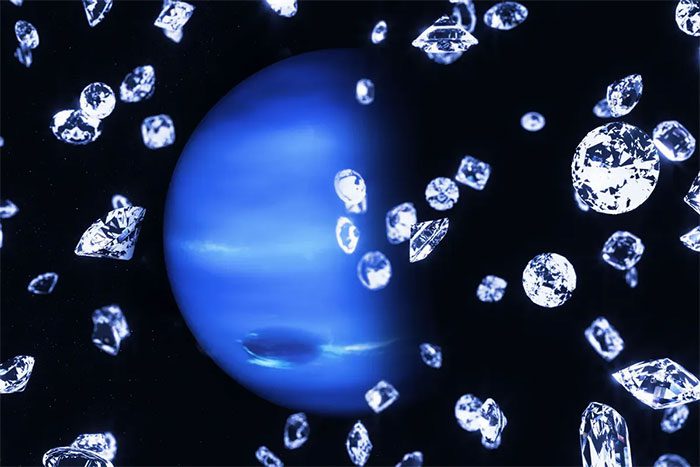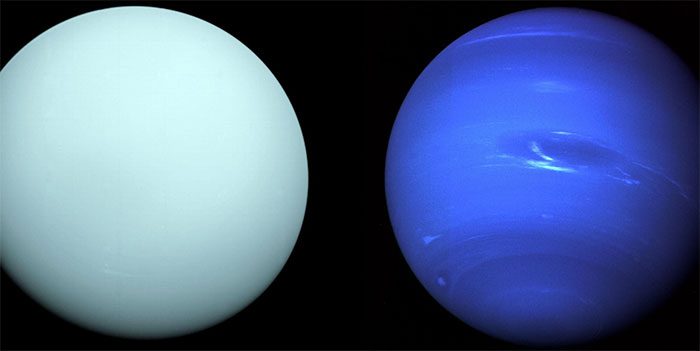Below the frigid hydrogen-helium atmosphere of Neptune and Uranus lies a liquid layer rich in water, ammonia, methane, and possibly something much more dazzling: diamonds. Scientists have long suspected that these super-hard gemstones could rain down from the outer layers of these giant ice planets, eventually reaching their rocky cores.
However, the interior of Uranus may not be as glamorous as once imagined. Theoretical results published on February 27 in the journal Nature Communications indicate that while ideal conditions for diamond formation may occur in Neptune’s mantle, they may not exist in Uranus. Yet, other researchers state that the interiors of these ice giants remain mysterious enough that confidently predicting diamond rain on both planets must await future exploratory missions to the outer Solar System.

Diamond Rain.
Dr. Ravit Helled from the University of Zurich, who was not involved in the research, stated: “Planets with masses similar to Uranus and Neptune appear to be quite common in the galaxy. Understanding what happens inside these giant ice planets is crucial for describing the characteristics of exoplanets, as well as for understanding our own origins.”
Diamonds in the Sky?
After the Voyager 2 spacecraft flew past these two ice giants in the 1980s, scientists noted that Neptune emits heat from within (also known as geothermal heat), whereas Uranus merely reflects energy it receives from the Sun. Researchers have debated explaining this difference ever since.
Jonathan Fortney from the University of California, Santa Cruz, added: “For decades, people have tried to think about why these two (Uranus and Neptune) are actually different, because they look so similar.”
The new study led by Bingqing Cheng from the Austrian Institute of Science and Technology suggests that diamond rain may be part of the solution to this puzzle. As the gemstones fall through the outer layers, they release gravitational energy in the form of heat. Although less visually striking than a burning asteroid entering our atmosphere, the principle is similar. Meteorites (or diamonds) rub against any material they fall through, and this friction generates heat.

Uranus and Neptune may seem similar but are actually different – (Photo: Internet).
When Cheng’s team calculated the “freezing point” of carbon under conditions like those on Neptune and Uranus, they discovered that there is a narrow temperature and pressure range ideal for diamond formation. Under these conditions, carbon and hydrogen separate from each other, condensing carbon into a carbon-rich liquid ideal for diamond formation. This condensed liquid could freeze into diamond rain.
Cheng and colleagues suggest that while this diamond weather phenomenon may occur on Neptune, the conditions do not align on Uranus. If true, this could help explain the mysterious dim glow of this planet compared to its sibling planet.
Unsolved Mysteries
However, both Fortney and Helled caution that scientists still do not fully understand what the insides of these giant ice planets are like. Humanity’s only close-up views of Uranus and Neptune were the flybys of Voyager 2. Until we return to explore the outer Solar System, it is difficult to say with certainty whether either planet experiences diamond rain.
In the meantime, building calculations from computer models about the “freezing point” of carbon on Uranus and Neptune will be a way to test the impact of diamonds on the planets’ heat sources. Fortney stated that scientists have a good understanding of how this works for helium rain on Saturn, but diamond formation on giant ice planets has not been incorporated into the latest models.
Fortney said: “To me, this study is trying to bring Uranus and Neptune to the same level of complexity. And so far, we haven’t reached that level yet.”
Scientists at the HZDR Research Center in Germany in 2022 used plastic to recreate the phenomenon of diamond crystallization on icy planets. Dominic Kraus mentioned that his team added oxygen to the reaction and found that “diamond rain” formed more easily.
Kraus and colleagues used PET plastic to attempt to create “nano diamonds.” In their experiment, the team directed a powerful laser beam at a film-thin material sample, heating it to 6,000 degrees Celsius in an instant. At the same time, they created a shock wave to compress the material to over 1 million times atmospheric pressure, lasting only a few nanoseconds.
Kraus noted: “So far, we have used hydrocarbon films for these types of experiments. We discovered that extreme pressure and high temperatures created very small diamonds, which we call nano diamonds.”
He added: “PET material has a good balance of carbon, hydrogen, and oxygen components, making it an excellent simulator for diamond formation processes on ice planets. The effect of oxygen accelerates the separation of carbon and hydrogen. Thanks to the influence of oxygen, carbon atoms can combine more easily and form diamonds.”
According to Kraus, diamonds on Neptune and Uranus could stack up to a thickness of hundreds of kilometers. Researchers have predicted that humanity may one day be able to mine diamonds from planets in the Solar System. They even envisioned a scenario where each mining trip could bring back tons of high-value gemstones.
The research by Kraus’s team not only enhances our understanding of the universe but also has practical applications for producing nanometer-sized diamonds.


















































